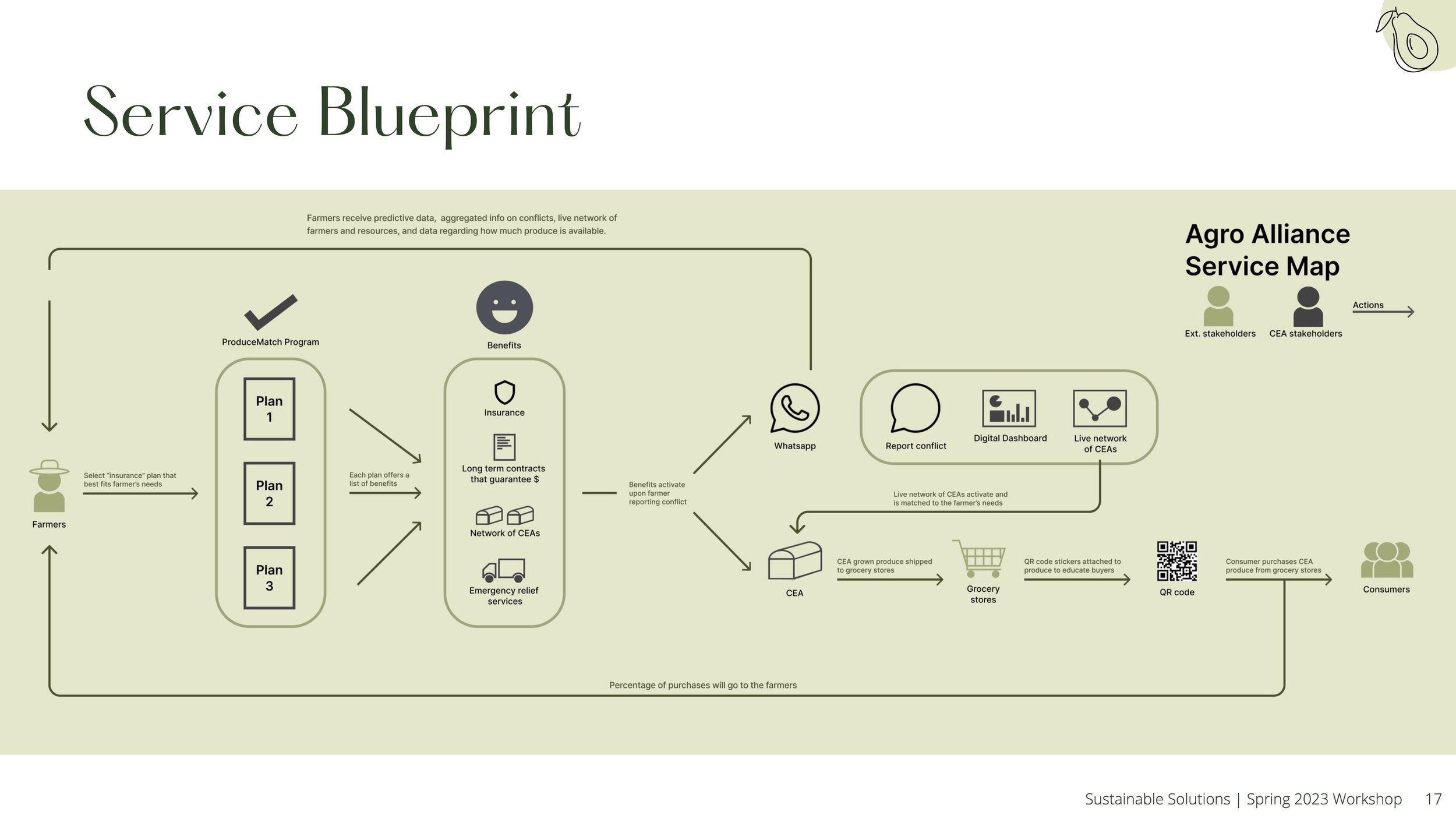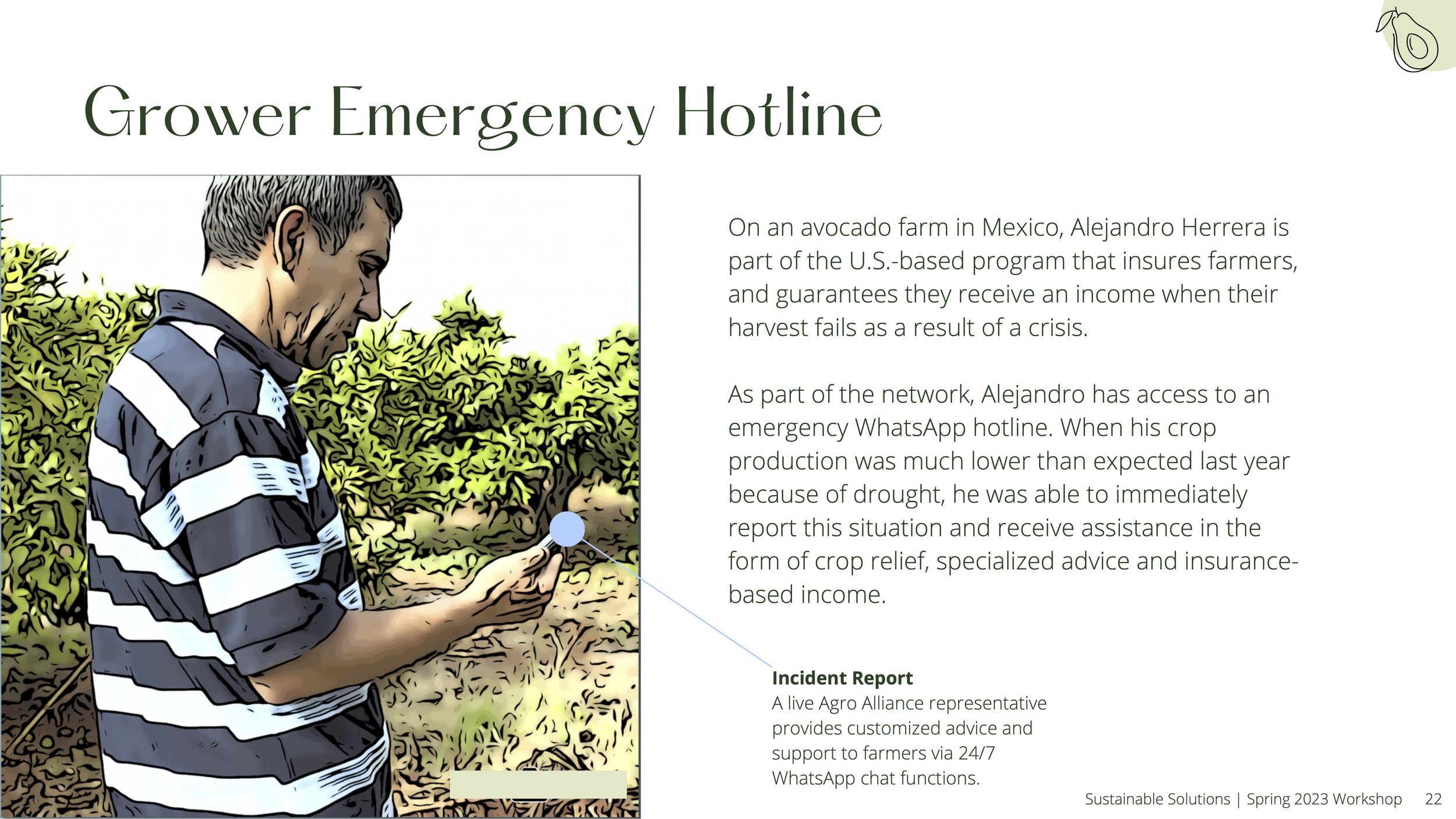Cultivating investment opportunities for CEAs through prototyping
The Future of Agriculture
Role: Strategist, prototyper, visual communicator
Focus: Strategy, systems thinking
Time: Jan - May ‘23 (14 weeks)
Team with our final prototypes
When thinking about where to play and how to win, design thinking can help us identify the right white spaces to play in that serve the business and the involved stakeholders. When thinking about opportunities for the future of controlled environment agricultures (CEA), our team found two key opportunities that can help us move towards a more just food system and food future.
Controlled environment agriculture provide growers with the ability to control their crop’s environment.
Context
Some examples of these include aquacultures, hydroponic farms, and vertical farms. However, when looked at through the lens of investable infrastructure, controlled environment agricultures (CEAs) also considers the production of agriculture, the post-production supply chain, and the moments before the consumption of food.
The challenge
CEAs are predicted to be a $378 billion industry by 2030 with an 18% compound annual growth rate,
But where should we play?
With the growth of CEA technologies and similar trends, capital investors have demonstrated interest in investing into CEAs, but finding strategies for "where to play" and "how to win" need to be investigated for a future that is at minimum, 10 years out into the future. When looking for investment opportunities, investors are looking for the following requirements:
Digitization
Decarbonization
Decentralization
Exploration of different investment strategies
Approach
Think visually to identify gaps
& opportunities.
When thinking of large-scale infrastructures within complex systems, it helped to think through our ideas visually so that we could identify gaps, key leverage points and create a starting point for discussion.
Learn through prototyping
& seek critique.
We really embraced learning and research through prototypes. Four rounds of rapid prototyping allowed for more sophisticated infrastructure iterations to be developed.
Research analogous situations & push for equity.
Our team not only found this as a unique opportunity to shape future business strategies, but to push for a more just food future. So by constantly asking for critique, we were able to find opportunities that envisioned a food system that prioritizes equity.
Driving insights
Photo from TIME
How can a CEA system combat the psychological barriers around insect protein consumption?
“He knew that crickets were healthy... but the psychological barriers were high... It took three attempts before he could relax enough to actually taste, chew and swallow the cricket... it was good. Really good... “It changed my life”
Food production is responsible for one quarter of global carbon emissions, and 30% of that comes from our traditional forms of protein production, like livestock and fisheries. With the rise of CEA technologies, are there opportunities for more sustainable land-based protein production?
While plant alternatives have been explored for protein production, the nutritional value of plant protein is significantly lower than animal protein, and so the demands on the CEA technology needed to produce animal protein to scale would be significant. On the other hand, insect proteins require much less space and energy, are highly nutritious, and are already consumed by some cultures around the world. But there’s a large stigma that prevents insect proteins from being consumed globally.
“For five years, it almost never rained. Then it did rain, and Jorge rushed his last seeds into the ground. The corn sprouted into healthy green stalks, and there was hope — until, without warning, the river flooded. Jorge waded chest-deep into his fields searching in vain for cobs he could still eat.”
Photo from ProPublica
How can CEAs create a more resilient food system for producers and customers in a changing climate future?
The future of food growth and production will inevitably be impacted by climate change. On top of that, many food production zones can also overlap with human conflict zones. Because of this, the future of our food system will be unstable, and especially for more seasonal product, this can also mean less food security and unstable prices.
While this is a challenge for the customer, it’s the most challenging for the growers and producers whose income relies on the stability of their crop growth. As reported by ProPublica, researchers project that by 2070, yields of some staple crops can decline by nearly a third. In some occasions, some farmers will have to completely migrate and start over.
Identified opportunities
1. The Insect Protein Market
Think: impossible meat + superfoods
A sustainable way to mass produce protein, the infrastructure around insect protein will allow for more localized and demand-responsive protein production. By leveraging insect protein’s existing presence in the pet food market and by starting with protein powder to introduce it to human diets, we believe that this has huge promise.
2. A Farmer Resiliency Network
(Agro Alliance)
Think: Fairtrade + AAA
By building an agricultural alliance network, farmers can rely on the CEA network to support them with emergency supply when their own farms are in conflict (environmental, or human). While the alliance wouldn’t be sufficient to substitute the full support a grower would obtain from their own crop, the network would act almost like insurance to support them until they get back on their feet.
Both of these strategies have the possibility to transform our food systems for the better, without compromising on profit and investment needs.

Our final CEA proposals were prototyped to an exhibition scale to demonstrate how the infrastructures could work as shown below:
Prototyping insect protein infrastructure
CEA infrastructure prototype
Education posters on cricket protein
Client order interface
Backend automation data hub
Prototyping the agro alliance network
Alliance network identifier stickers on produce
Education posters grower support and impact
Grower support interface
CEA automation hub







































